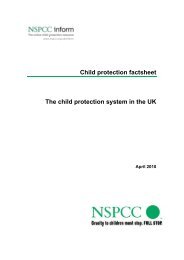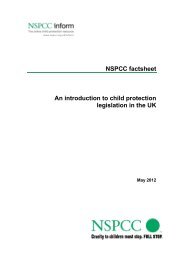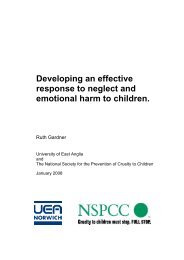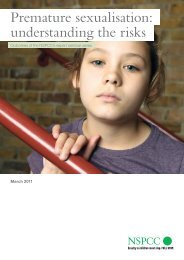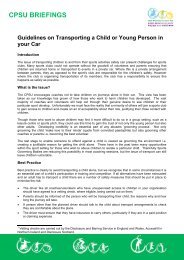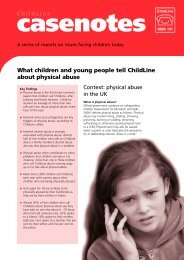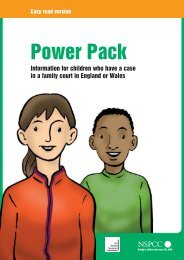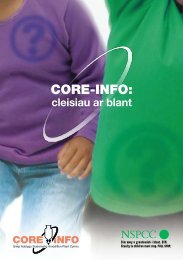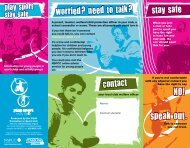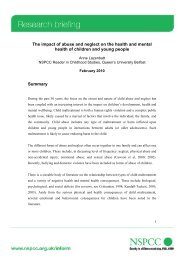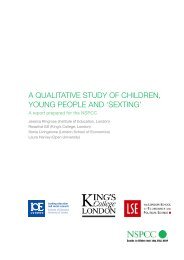Neglect and serious case reviews (PDF, 735KB) - nspcc
Neglect and serious case reviews (PDF, 735KB) - nspcc
Neglect and serious case reviews (PDF, 735KB) - nspcc
Create successful ePaper yourself
Turn your PDF publications into a flip-book with our unique Google optimized e-Paper software.
Sudi riSKS aNd targeted iNterveNtioN<br />
3. A thematic analysis of neglect<br />
Whilst stating that these deaths were not predictable, these <strong>serious</strong> <strong>case</strong> <strong>reviews</strong> did<br />
allude to missed opportunities to intervene which may have made a difference. Although<br />
the presence of neglect had been recognised, the potentially fatal outcome for the infant<br />
had not. The kind of issues arising are summarised below:<br />
• In one <strong>case</strong> advice about reducing the risk of SIDS was not formally recorded in<br />
midwifery or health visiting records, so may or may not have been delivered to the<br />
parents.<br />
• Lack of basic health promotion regarding cigarette smoking <strong>and</strong> SUDI risk, for<br />
example in one <strong>case</strong> there was no evidence that the ‘reducing risks of cot death’ leaflet<br />
(designed to be given if anyone in household smokes) was given.<br />
• An SCR relating to an incident that took place over the Christmas period highlighted<br />
that although there was a need to be especially alert to alcohol abuse by the parents<br />
<strong>and</strong> the children being put at risk, there was no evidence of any assessment by the<br />
health visitor in respect of this. The report writer suggests that this should have been<br />
part of the child protection plan.<br />
• In a further example, the health professionals had recognised the possibility of cosleeping<br />
as a potential risk, advice had been given accordingly. However, in this <strong>case</strong><br />
professional judgement had been made that the benefits of parental care for the child<br />
outweighed what were understood to be the possible rather than probable dangers of<br />
co-sleeping.<br />
• Another overview report describes how although these issues had been discussed<br />
with the mother, who stated that a Moses basket had been provided for the baby its<br />
existence was not checked, as access to the bedroom was refused. In the event, she<br />
revealed following the baby’s death that he had slept with her.<br />
Sudden infant death is one of the more preventable of child deaths, <strong>and</strong> indeed since<br />
the ‘Back to Sleep’ campaign of the early 1990s there has been a dramatic reduction<br />
in incidence. However, a higher proportion of residual sudden infant deaths now occur<br />
among more vulnerable families living in areas of high deprivation (Blair et al 2006,<br />
Wood et al 2012). A recent <strong>case</strong>-control study of SIDS in south west Engl<strong>and</strong> showed<br />
that many of these deaths occurred in a potentially hazardous sleeping environment,<br />
including sofa sharing with an adult who had recently consumed alcohol or narcotics<br />
(Blair et al 2009). The authors conclude that the major influences on risk ‘are amenable<br />
to change <strong>and</strong> specific advice needs to be given, particularly on use of alcohol or drugs<br />
before co-sleeping <strong>and</strong> co-sleeping on a sofa’.<br />
These are new findings <strong>and</strong> efforts need to be made for this knowledge to become<br />
incorporated into professional practice. One example of innovative work in this respect<br />
is a recent campaign in Lancashire developed in response to the high number of Sudden<br />
Infant Deaths across the county. The campaign centred around safeguarding messages,<br />
aiming to raise awareness of associated risk factors as well as the preventative measures<br />
63




